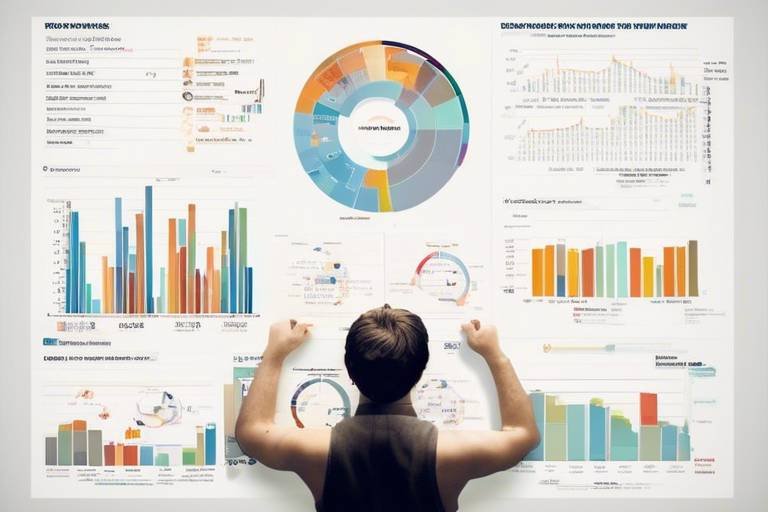How to Analyze Market Volatility for Trading Strategies
In the fast-paced world of trading, understanding market volatility is akin to having a compass in uncharted waters. It’s not just about knowing when to buy or sell; it’s about grasping the very nature of the market itself. Market volatility refers to the rate at which the price of an asset fluctuates over time. This can be influenced by various factors such as economic indicators, geopolitical events, and market sentiment. For traders, comprehending volatility is essential for crafting effective strategies that can withstand the unpredictable nature of the markets.
When you think about it, volatility is like the heartbeat of the market. Just as a doctor checks for a healthy pulse, traders must monitor volatility to assess the market's health. A market with low volatility might suggest a calm sea, where prices move steadily, while high volatility can resemble turbulent waters, with prices swinging wildly. This understanding is crucial because it helps traders anticipate potential price movements and manage their risks effectively.
Moreover, analyzing market volatility allows traders to make informed decisions. Imagine you’re planning a road trip; you wouldn’t just jump in the car without checking the weather, right? Similarly, traders need to gauge the market conditions before making their moves. By understanding volatility, traders can better position themselves to capitalize on opportunities while minimizing potential losses.
In this article, we will delve into various methods to assess market volatility, focusing on key indicators like the VIX index and Bollinger Bands. We will also explore several trading strategies that can be employed to take advantage of market fluctuations. Whether you’re a seasoned trader or just starting, understanding how to analyze market volatility is a skill that can significantly enhance your trading game.
Market volatility is a fundamental concept that every trader should familiarize themselves with. It is not merely a statistic; it is a reflection of the market's emotional state. When traders are uncertain, volatility tends to rise. Conversely, when confidence is high, volatility often decreases. This emotional aspect is what makes volatility both a challenge and an opportunity for traders.
One way to visualize volatility is to think of it as a roller coaster. The steep climbs represent periods of uncertainty and potential profit, while the drops can signify losses. Understanding this dynamic can help traders prepare for the ride ahead. It’s about anticipating the ups and downs and knowing when to hold on tight or let go.
To navigate the complex world of market volatility, traders rely on various indicators that provide insight into price movements. Here are some key indicators that can significantly enhance your trading strategy:
- The VIX Index: Often referred to as the "fear gauge," the VIX measures market expectations of near-term volatility. It’s a crucial tool for assessing market sentiment.
- Bollinger Bands: This technical analysis tool visualizes volatility and consists of a moving average and two standard deviation lines. It helps traders identify potential price breakouts.
By familiarizing yourself with these indicators, you can gain a clearer understanding of market conditions and make more informed trading decisions.
The VIX index is a powerful tool in a trader's arsenal. It provides a snapshot of market expectations regarding future volatility. When the VIX is high, it indicates that traders expect significant price fluctuations, often due to uncertainty or fear in the market. Conversely, a low VIX suggests that traders anticipate a stable market environment.
Interpreting the VIX involves analyzing its levels in relation to historical data. A high VIX level may indicate increased market fear, while low levels suggest stability. Understanding these levels can help traders make better decisions about when to enter or exit trades.
Traders can leverage the VIX to gauge market sentiment and make informed decisions. For example, if the VIX is spiking, it might be a signal to consider protective strategies, while a declining VIX could suggest a good time to enter the market.
Bollinger Bands are another essential tool for traders looking to visualize volatility. They consist of a middle band (a moving average) and two outer bands that represent standard deviations from the average. When the bands widen, it indicates increased volatility, while narrowing bands suggest reduced volatility. This visualization helps traders identify potential price breakouts and reversals.
Traders can employ various strategies to capitalize on market volatility. Understanding these strategies can provide a significant edge in the trading arena. Here are a few popular approaches:
Straddles involve buying both call and put options at the same strike price, allowing traders to profit from significant price movements in either direction. On the other hand, strangles utilize different strike prices for calls and puts. Both strategies can be highly effective in volatile markets, but they come with their own risks and rewards.
Volatility breakout strategies focus on identifying price movements beyond established support and resistance levels. When prices break through these barriers, it often leads to rapid price changes, providing traders with opportunities to make profitable trades.
Q: What is market volatility?
A: Market volatility refers to the rate at which the price of an asset increases or decreases over time. It's a measure of how much the price fluctuates.
Q: How can I measure market volatility?
A: You can measure market volatility using indicators like the VIX index and Bollinger Bands, which provide insights into expected price movements.
Q: What are some strategies for trading volatility?
A: Some popular strategies include straddles, strangles, and volatility breakout strategies, each designed to capitalize on significant price movements.

Understanding Market Volatility
Market volatility is a term that often gets tossed around in trading circles, but what does it really mean? In simple terms, market volatility refers to the rate at which the price of an asset fluctuates over a specific period. Imagine you're on a roller coaster; the ups and downs represent the price movements in the market. Just like that thrilling ride, the more twists and turns there are, the more volatile the market is considered to be. Understanding this concept is crucial for traders because it can significantly impact their strategies and outcomes.
Volatility is not inherently bad or good; it simply indicates the level of uncertainty or risk associated with an asset's price movements. For instance, a stock that experiences wild swings in price might be seen as risky, but it also presents opportunities for traders looking to capitalize on those price changes. Conversely, a stock that remains fairly stable might seem safer but could offer limited profit potential. Thus, understanding volatility helps traders gauge the risk-reward ratio of their trades.
There are two main types of market volatility: historical volatility and implied volatility. Historical volatility measures how much an asset's price has fluctuated in the past, while implied volatility reflects the market's expectations of future volatility based on option prices. Both types provide valuable insights into market behavior. Traders often analyze these metrics to make informed decisions.
To further illustrate the concept, consider the following table that compares historical and implied volatility:
| Type of Volatility | Description | Use in Trading |
|---|---|---|
| Historical Volatility | Measures past price fluctuations | Helps in assessing risk based on historical price behavior |
| Implied Volatility | Reflects market expectations of future volatility | Guides traders in option pricing and strategy development |
Understanding market volatility is not just about knowing the numbers; it’s about interpreting what they mean for your trading strategy. Are you willing to embrace the risk for potentially higher rewards, or do you prefer the security of more stable assets? This self-awareness can guide your trading choices and help you develop a strategy that aligns with your risk tolerance.
In conclusion, market volatility is a double-edged sword. It can create opportunities for profit but also exposes traders to significant risks. By grasping the nature of volatility and how it influences market dynamics, you can position yourself to make better-informed trading decisions. So, the next time you hear someone mention volatility, remember that it’s not just a buzzword; it’s a crucial element of successful trading.

Key Indicators of Volatility
When diving into the world of trading, understanding market volatility is like having a compass in uncharted waters. It guides you through the unpredictable tides of price movements, helping you make informed decisions. Several key indicators can help you measure and interpret this volatility effectively. Among these, the VIX index and Bollinger Bands stand out as essential tools in a trader's toolkit.
The VIX index, often dubbed the "fear gauge," is a popular measure of expected market volatility based on S&P 500 index options. It represents the market's expectations of future volatility and serves as a barometer of investor sentiment. When the VIX spikes, it usually signals heightened fear and uncertainty in the market, which can lead to significant price swings. Conversely, a low VIX indicates a calmer market environment, suggesting stability and lower risk.
But how do you interpret the VIX in practical terms? Consider the following:
| VIX Level | Market Sentiment | Implication |
|---|---|---|
| Below 20 | Low Volatility | Stable market conditions |
| 20 - 30 | Moderate Volatility | Potential for price fluctuations |
| Above 30 | High Volatility | Increased market fear and uncertainty |
This table gives you a quick snapshot of how different VIX levels correlate with market sentiment. When the VIX rises above 30, it’s often a sign that traders should brace for turbulence. On the flip side, a VIX under 20 might suggest it’s a good time to enter positions, as the market is likely to be more stable.
Next up, we have Bollinger Bands, another fantastic tool for visualizing volatility. They consist of a simple moving average (SMA) and two standard deviation lines that form a band around the price chart. When the price moves closer to the upper band, it suggests that the asset may be overbought, while touching the lower band indicates it may be oversold. The distance between these bands widens or narrows based on market volatility. A wider band indicates high volatility, while a narrower band suggests low volatility.
Understanding these indicators allows traders to gauge market conditions effectively. For instance, if you notice the Bollinger Bands are tightening, it could signal an impending price breakout, making it a prime opportunity for traders looking to capitalize on upcoming volatility.
In summary, familiarizing yourself with key indicators like the VIX and Bollinger Bands is crucial for developing a robust trading strategy. They not only help in assessing current market conditions but also assist in predicting future price movements. By mastering these tools, you can navigate the unpredictable waters of trading with greater confidence and insight.
- What is the VIX index? The VIX index measures market expectations of near-term volatility, serving as a gauge of investor sentiment.
- How do Bollinger Bands work? Bollinger Bands consist of a moving average and two standard deviation lines, helping traders visualize market volatility.
- Why is understanding volatility important for traders? Understanding volatility helps traders make informed decisions, manage risks effectively, and capitalize on price movements.

The VIX Index
The VIX Index, often referred to as the fear gauge, is a pivotal tool in the world of trading. It measures the market's expectations of volatility over the next 30 days, effectively serving as a barometer for investor sentiment. When traders talk about the VIX, they are usually discussing how nervous or confident the market feels. A high VIX indicates that traders expect significant price fluctuations, while a low VIX suggests a more stable market environment.
Understanding the VIX is essential for any trader looking to navigate the often turbulent waters of the financial markets. Imagine the VIX as a weather forecast for the stock market—just as you would check the weather before planning a picnic, savvy traders check the VIX to gauge whether it’s a good time to enter the market or to stay on the sidelines. This index is calculated based on the prices of options on the S&P 500, making it a reliable indicator of market sentiment.
To truly grasp the implications of the VIX, one must consider its historical context. For instance, the VIX tends to spike during periods of economic uncertainty or market downturns. In contrast, a low VIX often correlates with market rallies or periods of economic stability. This relationship can be visualized in the following table:
| VIX Level | Market Sentiment | Typical Market Condition |
|---|---|---|
| Above 30 | High Fear | Market downturn or uncertainty |
| 20 - 30 | Increased Fear | Potential volatility |
| Below 20 | Low Fear | Market stability |
Interpreting the VIX involves not just looking at its current level but also understanding its movement over time. For instance, if the VIX rises sharply, it can indicate that traders are bracing for significant market movements, which may prompt you to adjust your trading strategy. Conversely, if the VIX is falling, it may suggest that the market is stabilizing, potentially offering a safer environment for investments.
Furthermore, traders can use the VIX to inform their trading decisions. For example, if the VIX is on the rise, a trader might consider hedging their positions or even looking for opportunities to take advantage of potential price swings. On the other hand, a declining VIX might encourage traders to enter positions with greater confidence, expecting a more stable market. Ultimately, the VIX serves as a valuable tool for gauging market sentiment, helping traders make informed decisions about when to enter or exit positions.

fear gauge,
This article explores methods to assess market volatility, essential for developing effective trading strategies. Understanding volatility helps traders make informed decisions and manage risks effectively.
Market volatility refers to the rate at which the price of an asset increases or decreases for a given set of returns. Understanding its nature is crucial for traders.
Various indicators help measure market volatility, including the VIX index and Bollinger Bands. Familiarizing yourself with these tools can enhance your trading strategy.
The VIX index, often referred to as the fear gauge, measures market expectations of near-term volatility. Understanding its implications can aid in risk assessment.
Interpreting the VIX involves analyzing its levels in relation to historical data. High levels may indicate increased market fear, while low levels suggest stability.
Traders can use the VIX to make informed decisions about entering or exiting positions. It serves as a valuable tool for gauging market sentiment.
Bollinger Bands are a technical analysis tool that helps traders visualize volatility. They consist of a moving average and two standard deviation lines.
Traders can employ various strategies to capitalize on market volatility, such as straddles, strangles, and volatility breakout strategies. Each has its unique advantages and risks.
Straddles involve buying both call and put options at the same strike price, while strangles use different strike prices. Both strategies profit from significant price movements.
Volatility breakout strategies focus on identifying price movements beyond established support and resistance levels. Traders can benefit from rapid price changes following these breakouts.
The term fear gauge is commonly used to describe the VIX index, which acts as a barometer for market sentiment. When the VIX rises, it typically signals that investors are anticipating heightened volatility and are likely feeling anxious about future market conditions. Conversely, a declining VIX suggests a more stable market environment, where investors may feel more confident in their positions.
Understanding the fear gauge is crucial for traders because it provides insights into market psychology. When traders see a spike in the VIX, they might interpret it as a signal to exercise caution; this could mean tightening stop-loss orders or even hedging their positions. On the flip side, a low VIX may encourage traders to take on more risk, as it indicates a calmer market landscape.
To better illustrate the significance of the VIX, consider the following table that outlines the VIX levels and their corresponding market sentiment:
| VIX Level | Market Sentiment |
|---|---|
| Below 15 | Low Volatility / Confidence |
| 15 - 20 | Moderate Volatility / Caution |
| 20 - 30 | High Volatility / Fear |
| Above 30 | Extreme Volatility / Panic |
In summary, the fear gauge not only serves as an indicator of volatility but also reflects the emotional state of the market. By closely monitoring the VIX, traders can make more informed decisions and align their strategies with prevailing market conditions.
- What is the VIX index? The VIX index measures market expectations of near-term volatility, often referred to as the fear gauge.
- How can I use the VIX in my trading strategy? Traders can use the VIX to gauge market sentiment and make informed decisions about entering or exiting positions.
- What do high and low VIX levels indicate? High VIX levels indicate increased market fear, while low levels suggest stability and confidence among investors.

measures market expectations of near-term volatility. Understanding its implications can aid in risk assessment.
This article explores methods to assess market volatility, essential for developing effective trading strategies. Understanding volatility helps traders make informed decisions and manage risks effectively.
Market volatility refers to the rate at which the price of an asset increases or decreases for a given set of returns. Understanding its nature is crucial for traders.
Various indicators help measure market volatility, including the VIX index and Bollinger Bands. Familiarizing yourself with these tools can enhance your trading strategy.
The VIX index, often referred to as the fear gauge, measures market expectations of near-term volatility. Understanding its implications can aid in risk assessment.
Interpreting the VIX involves analyzing its levels in relation to historical data. High levels may indicate increased market fear, while low levels suggest stability.
Traders can use the VIX to make informed decisions about entering or exiting positions. It serves as a valuable tool for gauging market sentiment.
Bollinger Bands are a technical analysis tool that helps traders visualize volatility. They consist of a moving average and two standard deviation lines.
Traders can employ various strategies to capitalize on market volatility, such as straddles, strangles, and volatility breakout strategies. Each has its unique advantages and risks.
Straddles involve buying both call and put options at the same strike price, while strangles use different strike prices. Both strategies profit from significant price movements.
Volatility breakout strategies focus on identifying price movements beyond established support and resistance levels. Traders can benefit from rapid price changes following these breakouts.
- What is market volatility?
Market volatility refers to the degree of variation in trading prices over time, indicating how much the price of an asset fluctuates. - How does the VIX work?
The VIX is calculated based on the prices of options on the S&P 500 index, reflecting the market's expectations of future volatility. - What are some common strategies for trading volatility?
Common strategies include straddles, strangles, and volatility breakout strategies, each catering to different market conditions.

How to Interpret the VIX
Interpreting the VIX, often dubbed the fear gauge, is essential for any trader looking to navigate the turbulent waters of the stock market. The VIX measures the market's expectations of volatility over the next 30 days, and its levels can reveal a lot about investor sentiment. So, how do you make sense of the numbers? Let’s break it down.
First off, it's important to understand the historical context of the VIX. When you see a high VIX reading, typically above 30, it suggests that investors are bracing for significant market fluctuations. This heightened level of uncertainty can often correlate with market downturns. Conversely, a low VIX, usually below 20, indicates that the market is relatively stable, and investors are feeling more confident. It's like checking the weather before a big trip—if the forecast shows thunderstorms, you might want to rethink your plans!
To interpret the VIX effectively, consider the following:
- Historical Comparison: Compare the current VIX level with historical data. If the VIX is significantly higher than its average over a certain period, it might be time to assess your portfolio's risk.
- Market Movements: Look at the VIX in conjunction with market indices like the S&P 500. A rising VIX often accompanies a falling market, indicating that traders are hedging against potential losses.
- Trend Analysis: Observe the trend of the VIX over time. A consistent upward trend may signal increasing fear in the market, while a downward trend suggests a return to calm.
Moreover, understanding the implications of the VIX can significantly enhance your trading strategy. For instance, if you notice that the VIX is climbing, it might be prudent to consider protective strategies such as options or stop-loss orders. On the flip side, if the VIX is low, it could be an excellent opportunity to enter positions, as the potential for price movement is likely to increase.
In summary, interpreting the VIX is not just about looking at a number; it's about understanding the broader market context and making informed decisions based on that analysis. By keeping an eye on the VIX and its historical trends, you can better position yourself to navigate the complexities of market volatility.
- What does a high VIX indicate? A high VIX indicates increased market volatility and fear among investors, often correlating with market downturns.
- How often should I check the VIX? It's beneficial to check the VIX regularly, especially before making significant trading decisions or during periods of market uncertainty.
- Can I trade the VIX directly? Yes, you can trade the VIX through various financial instruments, including options and futures contracts.

Using VIX in Trading
The VIX, often dubbed the fear gauge, is not just a number; it’s a vital tool for traders looking to navigate the turbulent waters of the stock market. When you understand how to use the VIX effectively, it can become your compass, guiding you through the highs and lows of market volatility. So, how exactly can you leverage this index in your trading strategies? Let's dive in!
First off, traders can utilize the VIX to gauge overall market sentiment. When the VIX spikes, it usually indicates that investors are bracing for a bumpy ride ahead. This could be due to economic uncertainty, geopolitical tensions, or unexpected news events. In such scenarios, a high VIX can signal that it might be wise to exercise caution and possibly consider protective strategies, such as buying put options or hedging your portfolio.
Conversely, when the VIX is low, it suggests a sense of calm in the market. This might be the perfect time to consider entering long positions, as the market is likely to be more stable. However, it's crucial to remember that a low VIX does not guarantee that prices will rise; it simply indicates that traders are not expecting significant fluctuations in the near term.
Additionally, the VIX can be particularly useful in timing your trades. For instance, if you notice that the VIX has spiked significantly, it might be an opportune moment to look for entry points in options trading. You could consider strategies like straddles or strangles, which thrive on price movements, capitalizing on the volatility that the VIX is signaling. On the flip side, if you see the VIX trending downward, it could be a sign to lock in profits and exit your positions before the market becomes too complacent.
Moreover, integrating the VIX into your trading strategy allows you to create a more robust risk management plan. By monitoring the VIX alongside your other technical indicators, you can better assess when to adjust your stop-loss orders or take profits. For instance, a sudden spike in the VIX might prompt you to tighten your stops to protect against potential downturns.
In summary, the VIX is not just a standalone indicator; it’s a powerful ally in your trading arsenal. By understanding how to interpret its movements and applying that knowledge to your trading strategies, you can enhance your ability to make informed decisions in a volatile market. Remember, the key is to stay flexible and responsive to what the VIX is telling you. It’s like having a weather forecast for your trading journey—knowing when to brace for storms and when to enjoy the sunshine can make all the difference!
- What is the VIX index? The VIX index measures the market's expectations of future volatility, often referred to as the "fear gauge".
- How can I use the VIX in my trading strategy? Traders can use the VIX to gauge market sentiment, identify entry and exit points, and enhance risk management.
- Is a high VIX always bad for trading? Not necessarily. A high VIX can indicate opportunities for profit in volatile markets, especially with options strategies.

Bollinger Bands
Bollinger Bands are a powerful technical analysis tool that traders use to assess market volatility and potential price movements. Developed by John Bollinger in the 1980s, these bands consist of three lines: the middle band, which is a simple moving average (SMA), and two outer bands that are calculated based on the standard deviation of the price. The distance between these bands varies with market volatility, expanding during periods of high volatility and contracting during low volatility.
To put it simply, think of Bollinger Bands as an elastic band around the price of an asset. When the price moves outside the bands, it can indicate a potential trend reversal or continuation. For instance, if the price breaks above the upper band, it might suggest that the asset is overbought, while a move below the lower band could indicate it is oversold. This dynamic can help traders make informed decisions about when to enter or exit trades.
To better understand how Bollinger Bands work, let’s break down their components:
| Component | Description |
|---|---|
| Middle Band | Simple Moving Average (SMA) of the asset's price, typically over 20 periods. |
| Upper Band | Middle Band + (Standard Deviation x 2) - Represents the upper threshold of price movement. |
| Lower Band | Middle Band - (Standard Deviation x 2) - Represents the lower threshold of price movement. |
When using Bollinger Bands, it’s essential to consider the context in which they are applied. For example, in a trending market, prices may frequently touch or even exceed the upper or lower bands, indicating strong momentum. Conversely, in a sideways market, prices may oscillate between the bands, suggesting a lack of direction. Understanding these nuances can significantly enhance your trading strategy.
Moreover, traders often combine Bollinger Bands with other indicators to confirm signals and improve their trading decisions. For instance, using the Relative Strength Index (RSI) alongside Bollinger Bands can provide additional insights into whether an asset is overbought or oversold, further refining entry and exit points.
In summary, Bollinger Bands are not just a standalone tool; they are most effective when integrated with other analytical methods. By incorporating them into your trading strategy, you can gain a clearer picture of market volatility and make more informed decisions that align with your trading goals.
- What do Bollinger Bands indicate? Bollinger Bands indicate volatility and potential price movements based on the relationship between the price and the bands.
- How do I use Bollinger Bands in my trading strategy? You can use Bollinger Bands to identify overbought or oversold conditions, confirming signals with other indicators.
- Can Bollinger Bands be used in all markets? Yes, Bollinger Bands can be applied to various markets, including stocks, forex, and cryptocurrencies.

Strategies for Trading Volatility
When it comes to navigating the unpredictable waters of the financial markets, having a solid strategy for trading volatility is essential. Volatility can be your best friend or your worst enemy, depending on how you approach it. Just like a surfer riding a wave, traders must learn to harness the energy of market fluctuations to their advantage. There are several strategies that traders employ to capitalize on these price swings, and understanding these methods can significantly enhance your trading game.
One of the most popular strategies is the use of straddles and strangles. Both of these strategies are options trading techniques that allow traders to profit from significant price movements, regardless of the direction. A straddle involves buying both a call and a put option at the same strike price, which means you’re betting on a big move in either direction. It’s like placing a bet on a horse race; you’re not sure which horse will win, but you’re confident one of them will. On the other hand, a strangle involves purchasing a call and a put option at different strike prices. This strategy can be less expensive than a straddle, but it also requires a more significant price movement to be profitable. Both strategies can be particularly effective during earnings reports or major economic announcements when volatility tends to spike.
Another intriguing approach is the volatility breakout strategy. This strategy focuses on identifying key support and resistance levels on a price chart. When the price breaks through these levels, it often leads to rapid price changes. Think of it like a pressure cooker; once the lid blows off, the steam (or price movement) can surge dramatically. Traders using this strategy will typically look for setups where the market has been consolidating before a breakout, indicating that a significant move is imminent. This can be a thrilling and rewarding strategy, but it requires careful monitoring and timing to execute effectively.
To help visualize these strategies, consider the following table that outlines their key features:
| Strategy | Description | When to Use |
|---|---|---|
| Straddle | Buying call and put options at the same strike price. | During major news events or earnings reports. |
| Strangle | Buying call and put options at different strike prices. | When expecting significant price movement but unsure of direction. |
| Volatility Breakout | Trading based on price movements beyond support and resistance levels. | In a consolidating market before a breakout. |
Before diving into these strategies, it’s crucial to understand the risks involved. Volatility trading can lead to substantial profits, but it can also result in significant losses if not managed properly. Always ensure you have a solid risk management plan in place, which might include setting stop-loss orders and adjusting your position sizes according to your risk tolerance. Remember, trading is not just about making money; it’s also about protecting what you have.
In conclusion, trading volatility can be both exhilarating and daunting. By employing strategies like straddles, strangles, and volatility breakouts, you can position yourself to take advantage of market fluctuations. However, as with any trading strategy, it’s essential to stay informed, remain disciplined, and approach the market with a clear plan. The world of trading is filled with opportunities, and with the right strategies, you can navigate the choppy waters of volatility like a pro.
- What is market volatility?
Market volatility refers to the rate at which the price of an asset increases or decreases for a given set of returns. High volatility means prices are changing rapidly, while low volatility indicates a more stable market. - How do I measure market volatility?
Market volatility can be measured using various indicators, including the VIX index, Bollinger Bands, and historical price movements. - What are straddles and strangles?
Straddles involve buying both a call and a put option at the same strike price, while strangles involve buying options at different strike prices. Both strategies profit from significant price movements. - What is a volatility breakout strategy?
A volatility breakout strategy focuses on identifying price movements beyond established support and resistance levels, allowing traders to capitalize on rapid price changes.

Straddles and Strangles
When it comes to navigating the unpredictable waters of market volatility, straddles and strangles are two strategies that stand out like beacons of hope for traders. Both strategies are options trading techniques designed to capitalize on significant price movements, regardless of the direction. Imagine you're standing at a crossroads, with the potential for a wild ride ahead. Straddles and strangles allow you to prepare for that ride, no matter which path the market decides to take.
Let’s break it down a bit. A straddle involves buying both a call option and a put option at the same strike price, with the same expiration date. This means you’re betting that the price of the underlying asset will move significantly, either up or down. Picture it as a tightrope walker: they’re equally prepared to lean left or right, depending on how the winds blow. If the asset’s price soars or plummets, you stand to gain from one of the options while your losses on the other are limited.
On the other hand, a strangle is similar but with a twist. Here, you purchase a call option and a put option at different strike prices, again with the same expiration date. Think of it as a wider net cast into the market. This strategy usually requires a smaller initial investment compared to straddles since the options are typically out-of-the-money. However, it also means that the asset needs to move further away from the strike prices for you to start seeing profits. It's like fishing in a bigger pond—there's a chance for a bigger catch, but you may have to wait longer for the right moment.
Now, you might wonder: why would a trader choose one over the other? Well, it often comes down to the trader's expectations for volatility and the cost of the options. Straddles can be more expensive due to the simultaneous purchase of options at the same strike price, but they offer a higher potential payoff if the market makes a significant move. Strangles, while cheaper, require a more substantial price movement to become profitable. It's all about weighing your options and understanding your risk tolerance.
Here's a quick comparison to help visualize the differences:
| Feature | Straddle | Strangle |
|---|---|---|
| Strike Price | Same for both options | Different for call and put options |
| Cost | Generally higher | Generally lower |
| Profit Potential | Higher with significant movement | Requires larger movement to profit |
| Market Conditions | Best in high volatility | Best in moderate to high volatility |
In summary, whether you choose to straddle or strangle, the key is to stay informed and ready. Both strategies have their unique advantages and can be powerful tools in a trader's arsenal. So, the next time you sense a storm brewing in the market, consider these strategies as your safety harnesses, prepared to catch you as you navigate the ups and downs of trading.
- What is the main difference between straddles and strangles? Straddles involve options at the same strike price, while strangles use different strike prices.
- Which strategy is more expensive? Straddles are generally more expensive due to the simultaneous purchase of options at the same strike price.
- When should I use a straddle? Use a straddle when you expect high volatility and significant price movement.
- What are the risks associated with these strategies? The main risk is that if the asset price doesn’t move significantly, you could lose the premium paid for the options.

Volatility Breakout Strategies
When it comes to navigating the unpredictable waters of trading, can be your lifeboat. These strategies focus on identifying significant price movements that occur beyond established support and resistance levels. Picture this: you’re standing at the edge of a cliff, peering down at the ocean below. The waves crash against the rocks, and you know that when the tide shifts, it can either pull you under or propel you forward. In trading, those waves represent volatility, and knowing when to jump in can make all the difference.
At its core, a volatility breakout strategy is about anticipating rapid price changes. When a stock or asset breaks through a resistance level, it often signals the start of a new trend. Conversely, if it falls below a support level, it might indicate a downward trend. This is where traders can capitalize on the momentum created by such breakouts. But how do you effectively identify these breakouts?
One effective method is to use technical indicators. For instance, combining the Bollinger Bands with the Relative Strength Index (RSI) can provide insights into potential breakout points. When the price touches the upper band of the Bollinger Bands and the RSI shows overbought conditions, it might be a signal to sell or short the asset. On the flip side, if the price hits the lower band and the RSI indicates oversold conditions, it could be a great buying opportunity.
Another crucial aspect of volatility breakout strategies is timing. Traders often use candlestick patterns to gauge market sentiment. For example, a bullish engulfing pattern following a consolidation phase can suggest that the price is about to break out to the upside. Similarly, a bearish engulfing pattern can indicate a potential drop. Understanding these patterns can help traders position themselves correctly before the breakout occurs.
Moreover, setting stop-loss orders is essential when employing these strategies. Since breakouts can sometimes lead to false signals, having a stop-loss in place can protect your investment. For instance, if you buy an asset after a breakout, placing a stop-loss just below the breakout point can help mitigate potential losses if the price reverses.
To summarize, volatility breakout strategies are about harnessing the power of price movements that occur beyond key levels. By utilizing technical indicators, understanding candlestick patterns, and implementing risk management techniques like stop-loss orders, traders can position themselves to profit from the inevitable shifts in market dynamics. Remember, the ocean of trading can be tumultuous, but with the right strategies, you can ride the waves instead of getting swept away.
- What is a volatility breakout? A volatility breakout occurs when the price of an asset moves beyond established support or resistance levels, often leading to significant price changes.
- How can I identify a volatility breakout? Traders can identify breakouts using technical indicators like Bollinger Bands and candlestick patterns, which signal potential price movements.
- What are the risks associated with volatility breakout strategies? The main risk is false breakouts, where the price may reverse after initially breaking a key level. Using stop-loss orders can help manage this risk.
- Can volatility breakout strategies be used in any market? Yes, these strategies can be applied in various markets, including stocks, forex, and commodities, as long as there is sufficient volatility.
Frequently Asked Questions
- What is market volatility?
Market volatility refers to the rate at which the price of an asset increases or decreases within a specific timeframe. It's like the heartbeat of the market—when it's racing, there's a lot of action, and when it's steady, things are calm.
- Why is understanding volatility important for traders?
Understanding volatility is crucial because it helps traders make informed decisions and manage risks effectively. Think of it as navigating through a storm; knowing how turbulent the waters are can help you steer your ship safely.
- What are the key indicators of market volatility?
Some key indicators include the VIX index and Bollinger Bands. The VIX, often called the "fear gauge," shows market expectations for near-term volatility, while Bollinger Bands help visualize price movements and volatility levels.
- How can I interpret the VIX index?
Interpreting the VIX involves looking at its levels compared to historical data. High VIX levels may signal increased market fear, while lower levels indicate a more stable environment. It's like checking the weather before heading out—knowing if it's stormy or sunny can change your plans!
- How do traders use the VIX in their strategies?
Traders utilize the VIX to make informed decisions about entering or exiting positions. By gauging market sentiment through the VIX, they can better assess when to jump in or out, much like a surfer waiting for the perfect wave.
- What are straddles and strangles in trading?
Straddles involve buying both call and put options at the same strike price, while strangles use different strike prices. Both strategies aim to profit from significant price movements, making them ideal for volatile markets.
- What are volatility breakout strategies?
Volatility breakout strategies focus on identifying price movements that exceed established support and resistance levels. Traders can benefit from rapid price changes that occur after these breakouts, like a balloon popping and sending confetti everywhere!



















